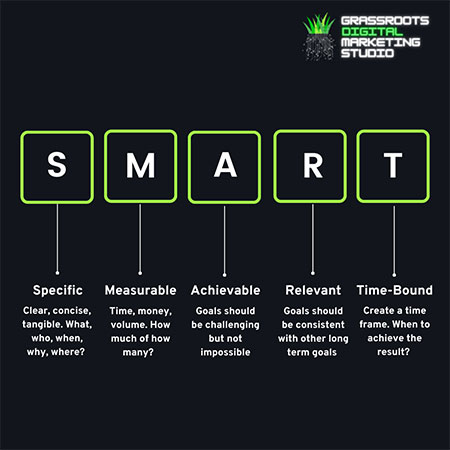3. Target User Personas
Now, this may not seem like the most important part of your marketing plan, but I think it holds a ton of value.
Outlining your user personas is an important part of a marketing plan that should not be overlooked.
You should be asking not just how you can get the most visitors to your business, but how you can get the right visitors.
Who are your ideal customers? What are their goals? What are their biggest problems? How does your business solve their problems?
Answering these questions will take lots of research, but it’s essential information to get.
Some ways to conduct user research are:
- Interviewing your users (either in person or on the phone)
- Conducting focus groups
- Researching other businesses in the same industry
- Surveying your audience
Then, you will need to compile your user data into a user persona guide.
Take a look at how detailed this user persona template is below:
Taking the time to identify specific demographic traits, habits and goals will make it easier for you to cater your marketing plan to them.
Here’s how you can create a user persona guide:
The first thing you should add is a profile picture or icon for each user persona. It can help to put a face to your personas, so they seem more real.
Next, list demographic information like:
- Age
- Job
- Income
- Identifiers
- Goals
- Challenges
- Activities/Hobbies
The user persona example above uses sliding scales to identify personality traits like introversion vs. extroversion and thinking vs. feeling. Identifying what type of personality your target users tend to have an influence the messaging you use in your marketing content.
Meanwhile, this user persona guide identifies specific challenges the user faces each day:
But if you don’t want to go into such precise detail, you can stick to basic information, like in this marketing plan example:
Most businesses will have a few different types of target users. That’s why it’s pertinent to identify and create several different user personas. That way, you can better segment your marketing campaigns and set separate goals, if necessary.
Here’s an example of what your segmented user persona guide could look like:
The important thing is for your team or client to have a clear picture of who their target user is and how they can appeal to their specific problems.
Start creating robust user personas using Venngage’s user persona guide.
4. Accurate Competitor Research
Next, on the marketing plan checklist, we have the competitor research section. This section will help you identify who your competitors are, what they’re doing, and how you could carve yourself a place alongside them in your niche–and ideally, surpass them. It’s something you can learn to do with a tool like GrowthBar.
Competitor research is also incredibly important if you are starting a blog.
Typically, your competitor research should include:
- Who their marketing team is
- Who their leadership team is
- What their marketing strategy is (this will probably revolve some reverse-engineering)
- What their sales strategy is (same deal)
- Social Media strategy
- Their market cap/financials
- Their yearly growth (you will probably need to use a marketing tool like Ahrefsto do this)
- The number of customers they have & their user personas
Also, take as deep a dive as you can into the strategies they use across their:
- Blog/Content marketing
- Social media marketing
- SEO Marketing
- Video marketing
- And any other marketing tactics they use
Research their strengths and weaknesses in all parts of their company, and you will find some great opportunities. Bookmark has a great guide to different marketing strategies for small businesses, if you need some more information there.
You can use this simple SWOT analysis worksheet to quickly work through all parts of their strategy as well:
Click the template above to create a swot chart. Customize the template to your liking–no design know-how needed.
Since you have already done all the research beforehand, adding this information to your marketing plan shouldn’t be that hard.
In this marketing plan example, some high-level research is outlined for 3 competing brands:
But you could take a deeper dive into different facets of your competitors’ strategies. For example, this marketing plan analyses a competitor’s content marketing strategy:
It can also be helpful to divide your competitors into Primary and Secondary groups. For example, Apple’s primary competitor may be Dell for computers, but its secondary competitor could be a company that makes tablets.
Your most dangerous competitors may not even be in the same industry as you. Like the CEO of Netflix said, “Sleep is our competition.”
5. Key Baselines
It’s pretty hard to plan for the future if you don’t know where your business stands right now.
Before we do anything at Venngage, we find the baselines so we can compare future results to something. We do it so much it’s almost like second nature now!
Setting baselines will allow you to more accurately track your progress. You will also be able to better analyze what worked and what didn’t work, so you can build a stronger strategy. It will definitely help them clearly understand your goals and strategy as well.
Here’s an example of how you can visualize your baselines in your marketing plan:
Another way to include baselines in your plan is with a simple chart, like in the marketing plan example below:
Because data can be intimidating to a lot of people, visualizing your data using charts and infographics will help demystify the information.
6. Actionable Marketing Strategy
After pulling all the contextual information and relevant metrics into your marketing plan, it’s time to break down your marketing strategy.
Once again, it’s easier to communicate your information to your team or clients using visuals.
Mind maps are an effective way to show how a strategy with many moving parts ties together. For example, this mind map shows how the four main components of a marketing strategy interact together:
You can also use a flow chart to map out your strategy by objectives:
However you choose to visualize your strategy, your team should know exactly what they need to do. This is not the time to keep your cards close to your chest.
Your marketing strategy section may need to take up a few pages to explain, like in the example below:
With all of this information, even someone from the Dev team would know what the marketing team was working on.
This minimalistic marketing plan example uses color blocks to make the different parts of the strategy easy to scan:
Breaking your strategy down into tasks will make it easier to tackle.
Another important way to visualize your marketing strategy is to create a project roadmap. A project roadmap visualizes the timeline of your product with individual tasks. Our roadmap maker can help you with this.
For example, this project roadmap shows how tasks on both the marketing and web design side run parallel to each other:
A simple timeline can also be used on your marketing plan:
Or a mind map, if you want to include a ton of information in a more organized way:
Even a simple “Next, Now, Later” chart can help visualize your strategy:
7. Results Tracking Guidelines
Close your marketing plan with a brief explanation on how you plan to track or measure your results. This will save you a lot of frustration down the line by standardizing how you track results across your team.
Like the other sections of your marketing plan, you can choose how in-depth you want to go. But there need to be some clear guidelines on how to measure the progress and results of your marketing plan.
At the bare minimum, your results tracking guidelines should specify:
- What you plan to track
- How you plan to track results
- How often you plan to measure
But you can more add tracking guidelines to your marketing plan if you see the need to. You may also want to include a template that your team or client can follow, to ensure that the right metrics are being tracked.
For example, the marketing plan example below dedicates a whole page to tracking criteria:
Use a checklist maker to not only track marketing results but also noting down tasks, important life events or tracking your daily life.
Similarly, the marketing plan example below talks about tracking content marketing instead:
7 Design Tips to Keep in Mind While You Create Your Marketing Plan
1. Identify, describe and illustrate your target audience
Knowing your target audience is one of the most fundamental steps that every marketing team should take before making any marketing decisions. So by the time you begin writing your marketing plan, you should have your target audience identified.
In your marketing plan, you should dedicate a section to introducing your target audience.
To help keep your target audience top-of-mind when planning and executing on your marketing strategies, it can be helpful to visualize your audience personas. Faux images of your personas, illustrations and icons are all great ways to put a face to your personas’ “names”.
For example, take this page from a marketing plan:
A photo of “Cassandra Vane”, their “head of marketing” persona, is provided to make the character seem more real. You can incorporate photos seamlessly into your page design by using image frames.
Icons are also used to visualize the different components that make up this persona (their identifies, their demographic information, their goals and their unique challenges).
2. Visualize important process flows and strategy roadmaps
To effectively outline new strategies, processes, and timelines, it can be very helpful to visualize the flows.
You could opt for a classic flow chart or a more creative infographic. Whatever type of visual you choose to create, the goal should be to make the information easier for people to follow.
The first step is to organize your flow into distinct steps. Remember to clearly label each step and to use symbols like lines or arrows to indicate the direction in which the flow should be read.
It can also be helpful to visualize each step using different shapes, or attaching an icon to each step.
For example, this page visualizes an email campaign flow:
Icons represent each email as an individual block, to make it easier for readers to visualize the process. Concise descriptions give readers context to understand the flow chart.
Take a look at how information flows visually throughout this promotional marketing plan template thanks to strategically placed visual cues:
3. Emphasize important statistics, metrics, and numbers in your marketing plan
To make your plan both more convincing, and easier to scan, you should create a hierarchy of information in your page design.
For example, you can use charts and pictograms to visualize important stats or metrics. Or you could write important numbers in a bright colored font so they stand out from the rest of the text.
This is an opportunity to get creative with your page design. For example, look at how speech bubble pictograms are used in this page to show key statistics:
In that same marketing plan, important content-related data is emphasized using brightly colored shapes, illustrative icons and big fonts:
Color choice, icons and font styles all help bring key information forward in this content strategy plan template:
4. Use your main marketing goal to guide your design
One of the main goals of your marketing plan is to identify your high-level marketing goals. Your marketing plan design should be driven by this goal–in your page layouts and in the design elements you use.
You can do this by picking a design motif that reflects your goal and using that throughout your marketing plan. This could be a particular shape or item (for example, using images of plants in a work plan to represent growth) or a color scheme that reflects the mood of your mission.
For example, this social media marketing plan identifies their goal as being the go-to source of inspiration and information for runners:
Take a look at how they use chat bubble icons and a bright, bold color scheme to give their marketing plan a friendly and energetic design:
Pro Tip: You don’t need to create a comprehensive marketing plan yourself. With our real-time collaboration feature (Business plan only) you can bring along your team to help you iron out your marketing plan together anytime, anywhere. In real-time.
5. Vary your page designs to make your marketing plan engaging
Putting in the extra bit of effort to use visuals will not only make your marketing plan more engaging, it will also make it easier for readers to retain information.
That’s why while you could use the same page layout throughout your whole plan, it’s a good idea to vary your page design. Mixing up your design will prevent your plan from being too predictable. Plus, you will have more flexibility to visualize information creatively.
For example, this SEO plan template simply inverts the color scheme on each page. While the overall color scheme for the whole plan is cohesive, each individual page is varied:
6. Visualize your top channels using charts, icons, and pictograms
It’s important for your team to understand what your highest performing channels. That way, you can identify areas you may want to funnel more resources into, whether it be social media, paid ads, mobile app advertising, organic or referral traffic.
This is where visual communication can be highly effective. A simple but effective way to analyze your channels is to visualize the data. You can do this using charts, pictograms and infographics with Venngage’s infographic creator.
For example, a pie chart can put into perspective where the bulk of your traffic is coming from:
A stacked bar would also work well to visualize this information.
You can also use icons to emphasize and differentiate between channels, like in this marketing plan slide:
Take a look at how charts, icons and color coding make it easy to scan this marketing agenda presentation for information about specific channels:
7. Use borders or color blocks to organize your pages into sections
Generally, it’s good practice to stick to one topic per page. This will help keep your marketing plan more organized and make it easier for readers to scan for information.
That being said, you may want to put more than one topic on the same page, like if both topics are directly related. In that case, you can organize the page into sections using borders or blocks of background color.
For example, look at how this page is clearly divided into two sections, thanks to the use of a color block background:
Blocks of color are also used to make the sections headers stand out. Take a look at the different pages in this promotional plan template:
A few more marketing plan design best practices:
Here are a few quick tips to keep in mind when start designing your marketing plan.
Keep your design elements like fonts, icons and colors consistent
While it’s good to switch up the layout of your pages to keep your marketing plan engaging, it’s important to keep your design consistent. That means:
- Using the same font styles for your headers, body text, and accent text (generally, try to stick to only using 2-3 different font styles in one report)
- Using the same color scheme throughout your plan, and using the same colors for specific types of information (ex. blue for “social media goals” and green for “SEO goals”)
- Using the same style of icons throughout your report, like flat icons, line art icons, or illustrated icons
Download your marketing plan as a PDF
It’s important that your team is on the same page. Sharing your marketing plan via Google Docs or a file sharing service can be unreliable. In most cases, it’s easier to simply download your marketing plan as a PDF and share it with your team that way.
You can download your marketing plan in high-quality PDF or interactive PDF format with Venngage.
Include a table of contents to make it easy to find specific information
This tip is pretty self-explanatory. Even if you’re putting together your marketing plan as a presentation, a simple table of contents at the beginning will give your audience an idea of what they can expect.
Now that you have the basics for designing your own marketing plan, it’s time to get started:









